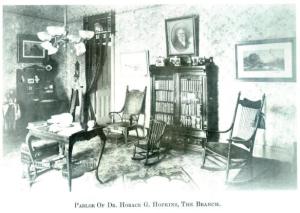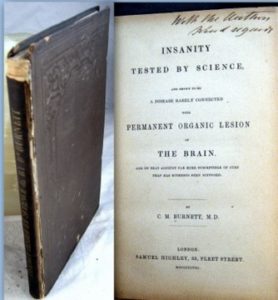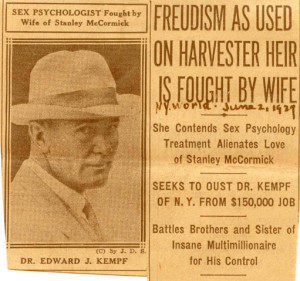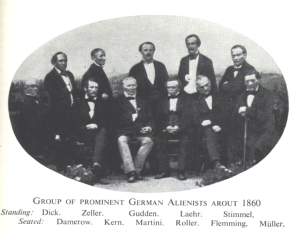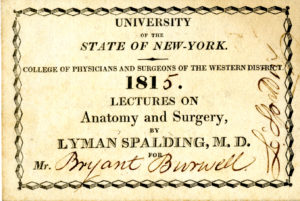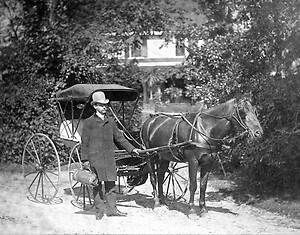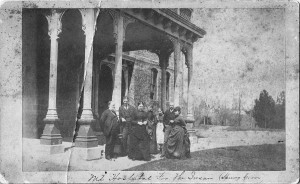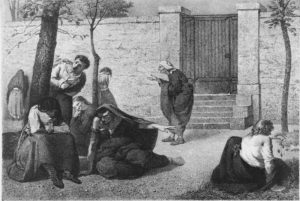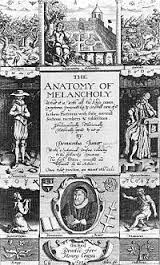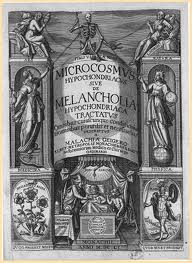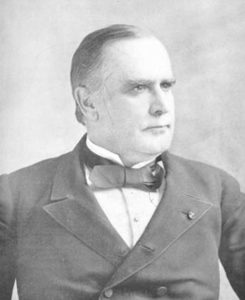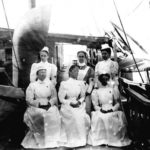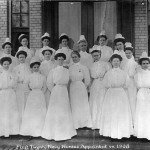Though early alienists did a great deal to de-stigmatize insanity and help families feel better about seeking help for their mentally ill members, insanity was still a delicate subject that most families preferred to keep private. Asylum superintendents understood this. Continue reading
Tag Archives: alienists
The Chronic Insane
Alienists stressed that the prompt treatment of insanity was imperative to a cure. They cautioned the public that it was far wiser to bring an afflicted person to an asylum for a cure as soon as possible, rather than let the patient languish at home for years until an asylum became a last resort. By that point, the disease might have too strong a hold and never be shaken. Continue reading
What Caused Insanity?
The causes for insanity that early alienists compiled can seem amusing–as well as appalling–to modern readers. Almost anything, from disappointment in love, financial reverses, over-study, improper diet, use of alcohol or tobacco, and masturbation could derail mental health, it seemed. However, most of these causes really stemmed from one primary cause: civilization. Continue reading
Change in the Air
Though 1903 continued in the same difficult pattern and lifestyle for most Americans (see last post), the year also saw many exciting changes. The Canton Asylum for Insane Indians, with its modern lighting and plumbing, reflected the wave of innovation and invention rippling throughout the country.
From 1900 – 1903:
- Henry Ford founded Ford Motor Company.
- Germans invented the zeppelin airship.
- Orville Wright made his first flight on the Wright Flyer.
- Guglielmo Marconi completed the first two-way wireless message
- Crayons were invented.
- Owen Wister wrote The Virginian.
Industrialization had come to the country, even though the majority of the population still lived in rural areas. Men, women, and children abandoned farms and sought the factory work which mechanical innovation made available.
Along with it came the ills of modern society and some new psychological problems. But, not to fear, for alienists were ready and willing to meet the challenges of the new era.
Patient Histories
An important innovation in the treatment of the insane was to obtain a history of patients’ past life and behavior. This allowed doctors to see how much the patient was deviating from previous behavior that was “normal” for that person; it also allowed them to see if anything important might have happened to cause the patient’s decline in mental health. Illnesses, shocks, losses, and so on could be precipitating events, as could lifestyle practices such as alcohol or opiate use. All mental illness wasn’t connected to outside factors, of course, but alienists began to realize that for them to understand and help patients, they had to understand what they had been like before they became insane.
Most patient records are missing from the existing files on the Canton Asylum for Insane Indians. Medical files seemed to have been fairly up-to-date when the asylum first opened, since the asylum’s assistant superintendent, Dr. John Turner, could ascertain the date of a patient’s pregnancy by the menstrual records he kept. When Dr. Harry Hummer took over as superintendent, one report mentioned that his record-keeping was modeled after that of St. Elizabeths, where he had been a physician. However, the doctor was criticized in later reports for poor record-keeping. The reports on patients that he sent to relatives varied little from month to month, and Hummer put a stop to even this slight gesture after a number of years.
When patients were transferred to St. Elizabeths after the Canton Asylum closed, staff reviewed what was known about them and then wrote their own assessments after a short period of observation. Sometimes these short notes are the only ones available, and they at least give a glimpse as to why a patient came to the asylum.
In my next couple of posts, I will share a few of these patients notes.
The Superiority of Superintendents
In the early 1800s, physicians were not particularly respected by the public. The educational requirements to become a doctor were minimal and no licensing was required; any ambitious young man could apprentice under a doctor for a couple of years or attend three or four semesters of lectures and then launch into his own practice. Few cures for disease existed, and many doctors knew no more about illness, its prevention, or its cure than an observant mother or wise and experienced grandmother. Medicines were another matter–many families relied on herbal and other natural preparations to ease symptoms of illness, but doctors could concoct and dispense stronger remedies full of alcohol or narcotics. Even with this patient incentive to visit a physician (or to request a house call), few doctors made a good living. Competition was fierce because of the lax requirements to enter the field, and many doctors found themselves sharing too few patients with far too many physicians.
When insane asylums were built, however, a few lucky physicians found a wonderful niche for their specialized medical interest. For alienists (doctors who made a special study of mental illness), managing an asylum was a secure, well-paying position with plenty of prestige and power. Rather than competing with any number of other physicians in a family practice, alienists were regarded everywhere as experts in their field and relied upon as such. Asylum superintendents enjoyed their authority and guarded it well. Besides protecting their own turf, they were united in opposing interference in their business from non-medical officials.
______________________________________________________________________________________
Treatments of Long Standing
Treatments for insanity were surprisingly consistent until the modern era. Bleeding, purging, forced vomiting, and other physical remedies were go-to procedures until the early 1800s. Purging (causing the bowels to evacuate) and vomiting continued into the nineteenth century. Physicians turned to opiates to sedate patients early in the seventeenth century, and they were still popular in the nineteenth.
Even “new” psychological treatments created in the nineteenth century had echoes of this earlier period. Alienists and asylum superintendents in the 1800s recommended a change of scenery and light amusements to divert the troubled mind, particularly for those who fell into depression or melancholy as it was popularly called. Robert Burton, an expert on melancholy who wrote almost 1,400 pages on the subject in 1620, called for those afflicted with the condition to “seek merry company, play at honest amusements, dress gaily, and haunt light and lovely places.” The two treatments are remarkably similar, even though the first was part of the newly emerging “moral treatment” pioneered in the early 1800s.
On a darker note, authorities in the 1600s often beat the insane in much the same way parents would discipline unruly children. Some of the beatings or other forceful remedies for “misbehavior” could be quite painful and dehumanizing. Moral treatment succeeded in reducing or stopping such punishment for the behaviors of the insane, and patients enjoyed much more humane treatment for several decades. Unfortunately, the more crowded insane asylums became, the more often attendants ended up resorting to these primitive methods for controlling behavior. Some of the worst ills of the asylum era ended up being physical abuse and the various restraining devises attendants used.
______________________________________________________________________________________
Alienists Gain Prominence
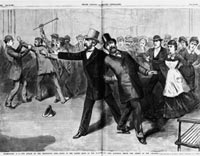
Print of Assassination Attempt, which appeared in Frank Leslie’s Illustrated Newspaper, July 16, 1881, courtesy Library of Congress
Charles Julius Guiteau shot President James Garfield at the Pennsylvania railroad station in Washington, DC on July 2, 1881. He did not try to escape and was apprehended on the spot; when the president died twelve weeks later, Guiteau went on trial for his murder. The public was fascinated and the trial became something of a media circus, with Guiteau’s behavior as avidly reported as the points made by the attorneys for the prosecution and defense. Continue reading
Tragedy After the War
Theodore Roosevelt’s public life soared after the Spanish-American War, but the president in office during that war suffered tragedy before his term ended.
An anarchist, Leon Czolgosz, shot President McKinley at the Pan American Exposition on September 6, 1901.
McKinley died of his wounds on the 14th, and Roosevelt took office. Continue reading
Gender Issues
Like blacks (see last post), women found it hard to enter the medical profession; in the U.S., women were kept out of hospitals almost entirely until the strain of caring for the wounded during the Civil War showed how valuable they were. Though a sprinkling of female doctors gained attention during the mid to late 1800s, most females in medicine were nurses. However, most did not consider work in mental institutions, where patients could be violent and destructive. Asylum nurses were usually men during much of the 1800s, though married couples sometimes worked together in wards. When female nurses did begin to work at large institutions, they did as much grunt work as compassionate care. Nurses were often expected to sweep and mop their wards, and perform many other housekeeping tasks. It is little wonder that they wanted and accepted help from patients. They had little time off, and were expected to follow doctor’s orders without argument.
By the turn of the century, alienists began to rethink their position on the use of female nurses in asylums. An article by Dr. Charles R. Bancroft (medical superintendent at New Hampshire State Hospital) in the October, 1906 issue of the American Journal of Insanity discussed how to use female nurses effectively. The author believed that it would be best to follow the example of regular hospitals, which gave head nurses both responsibility and authority. “There must of necessity be men attendants, but their position should be that of the general hospital orderly whose duty it will be to execute the orders of the head nurse,” said Bancroft. The doctor displayed both chauvinism and insight when he stated: “Woman are naturally better housekeepers than men,” and later, “. . . they are better nurses than men, but their qualifications never show for what they are worth unless the women are in the superior position.”
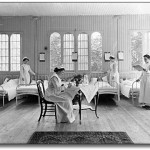
Infirmary Nurses in a Toronto Insane Asylum, circa 1910, courtesy Queen Street Mental Health Centre, Archives of Ontario
______________________________________________________________________________________
